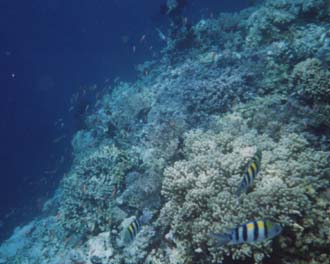
Coral reefs, like this one northwest of Bali,
Indonesia, are very sensitive to changes in seawater
temperature.
Click on image for full size
Courtesy of Lisa Gardiner
|
Over 100 years ago, people worldwide began burning more coal
and oil for homes, factories, and transportation. Burning these
fossil fuels releases
carbon dioxide and other
greenhouse gases into the
atmosphere. These added greenhouses gases have caused
Earth
to warm more quickly than it has in the past.
How much warming has happened? Scientists from around the
world with the
Intergovernmental Panel on Climate Change (IPCC) tell us
that during the past 100 years, the world's surface air
temperature increased an average of 0.6°
Celsius (1.1°F). This may not sound like very much
change, but even one degree can affect the
Earth.
Below are some effects of climate change that we see happening
now.
-
Sea level is rising. During the 20th
century, sea level rose about 15 cm (6 inches) due to
melting
glacier ice and
expansion of warmer seawater. Models predict that
sea level may rise as much as 59 cm (23 inches) during
the 21st Century, threatening coastal communities,
wetlands, and
coral reefs.
- Arctic sea ice is melting. The
summer thickness of sea ice is about half of what it was
in 1950.
Melting ice may lead to
changes in ocean circulation. Plus melting sea ice
is speeding up
warming in the Arctic.
- Glaciers and permafrost are melting.
Over the past 100 years, mountain
glaciers in all areas of the world have decreased in
size and so has the amount of
permafrost in the
Arctic.
Greenland's ice sheet is melting faster too.
- Sea-surface temperatures are warming.
Warmer waters in the shallow oceans have contributed to
the death of about a quarter of the world's
coral reefs in the last few decades. Many of the
coral animals died after weakened by bleaching, a
process tied to warmed waters.
- Heavier rainfall cause
flooding in many regions. Warmer temperatures
have led to more intense rainfall events in some areas.
This can cause flooding.
- Extreme drought is increasing.
Higher temperatures cause a higher rate of
evaporation and more drought in some areas
of the world.
- Ecosystems are changing. As
temperatures warm,
species may either move to a cooler habitat or die.
Species that are particularly vulnerable include
endangered species,
coral reefs, and
polar animals. Warming has also caused changes in
the timing of spring events and the length of the
growing season.
- Hurricanes have changed in frequency and
strength. There is evidence that the number of
intense
hurricanes has increased in the Atlantic since 1970.
Scientists continue to study whether climate is the
cause.
- More frequent
heat waves. It is likely that heat
waves have become more common in more areas of the
world.
- Warmer temperatures affect human health.
There have been more deaths due to heat waves and more
allergy attacks as the pollen season grows longer. There
have also been some changes in the ranges of animals
that carry disease like mosquitoes.
-
Seawater is becoming more acidic. Carbon
dioxide dissolving into the oceans, is making seawater
more acidic. There could be
impacts on coral reefs and other marine life.
The source of this material is Windows to
the Universe, at
http://windows2universe.org/ from the
National Earth Science Teachers
Association (NESTA). The Website was developed in part with
the support of UCAR and
NCAR, where it resided
from 2000 - 2010. © 2010 National Earth Science Teachers
Association. Windows to the Universe® is a registered
trademark of NESTA. All Rights Reserved.
Site
policies and disclaimer. |